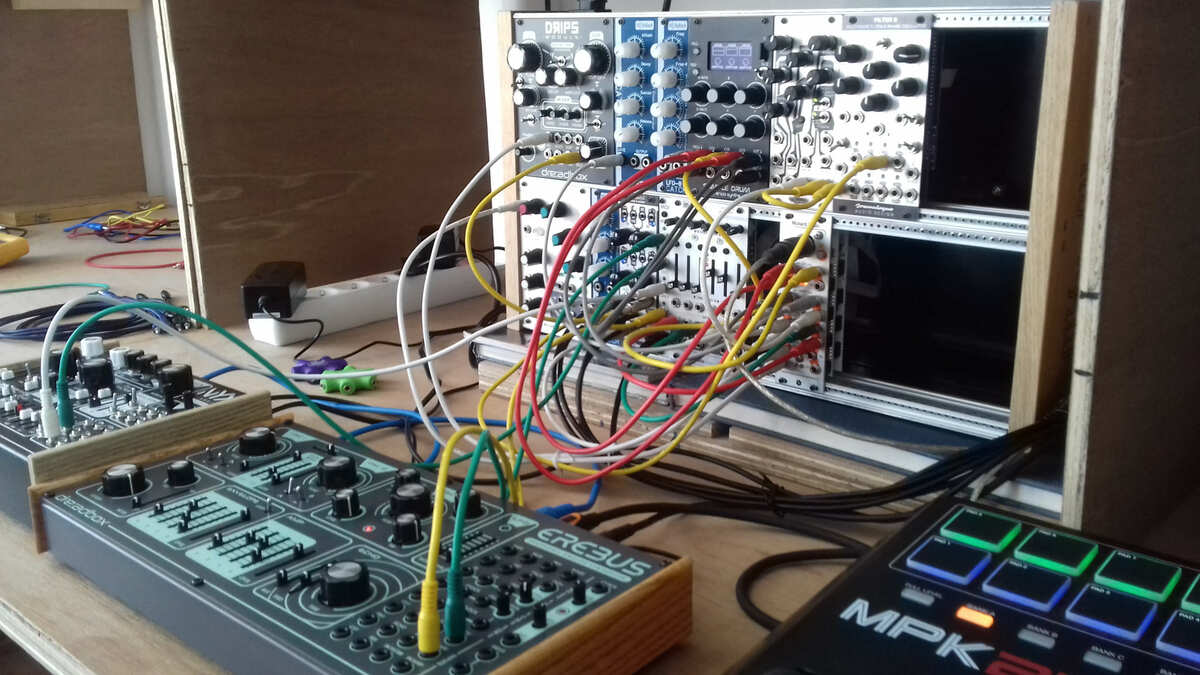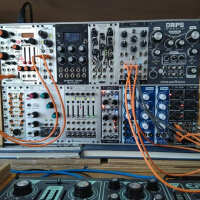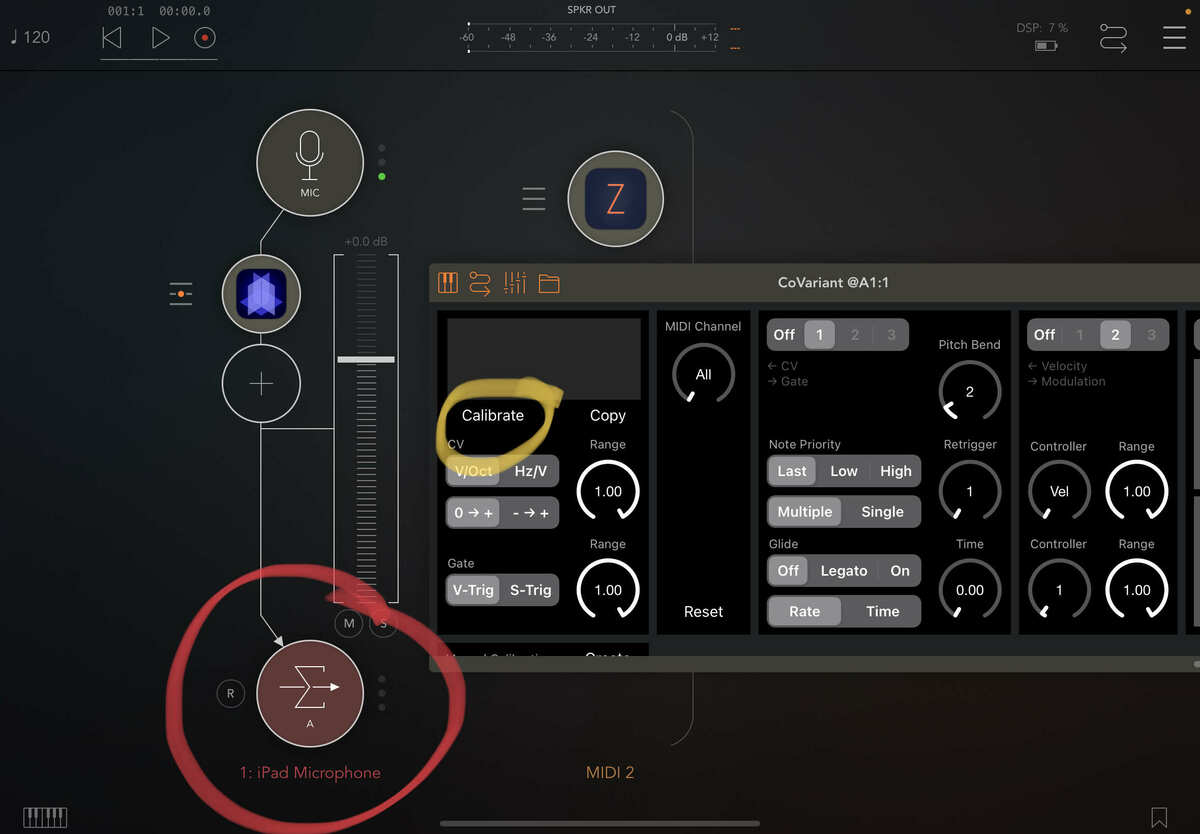Loopy Pro: Create music, your way.
What is Loopy Pro? — Loopy Pro is a powerful, flexible, and intuitive live looper, sampler, clip launcher and DAW for iPhone and iPad. At its core, it allows you to record and layer sounds in real-time to create complex musical arrangements. But it doesn’t stop there—Loopy Pro offers advanced tools to customize your workflow, build dynamic performance setups, and create a seamless connection between instruments, effects, and external gear.
Use it for live looping, sequencing, arranging, mixing, and much more. Whether you're a live performer, a producer, or just experimenting with sound, Loopy Pro helps you take control of your creative process.
Download on the App StoreLoopy Pro is your all-in-one musical toolkit. Try it for free today.
Connect Ipad to modular part 3


I have the iPad connected to a modular monster and it is great to have all the apps to bring the CV, gates and triggers to life.
I have the 2 HP MIDI & Mutant Brain working with a powered USB hub and an USB to MIDI (interface) cable.
However I'm experiencing a bit of a stepped resolution of LFO due the MIDI restrictions of CC I guess.
Using AUM and Bram Bos Rozeta LFOs
Is there any other way to get a smooth LFO out of this work flow besides the "pitch bend trick"?
The clock dividers, gates and triggers are ace so no complaints about that.



Comments
MIDI continuous controllers are confined to 128 steps by definition. The issue you're encountering is not unique to iOS, desktop systems are just as problematic with MIDI and modular communications without specialist solutions. I use a solution by Expert Sleepers, the ES-8, for communicating between desktop and modular control voltages.
The manual for the ES-8 mentions a few iOS apps that are compatible but how they could possibly fit with your specific challenge would be a question for the developers or owners of those specific apps (I don't own them so couldn't comment).
http://www.expert-sleepers.co.uk/es8.html
The apps which are listed as ES-8 compliant are zMors & Audulus.
@bennie: Audulus via ES-8 can create true smooth continuous non-MIDI-limited CVs. The folks on the Audulus forum are generous in helping people out with such things.
for MIDI to CV conversion there are interfaces with 16 bit D/A converter and internal smoothing. Kenton makes good ones. Myself I use a Kenton for an original MS-20 and other synths, and a Endorphines Shuttle Control module for my modular system. Both interfaces provide very smooth CV signals from MIDI CC, pitchbend, pitch.
https://www.kentonuk.com/products/items/m-cv/prosolo.shtml
Good suggestions here.
If you have an old MOTU audio interface laying around, you can use it to sent control voltage, instead of MIDI, to your Eurorack. Most of the output jacks on the MOTUs are DC-coupled, which means they don't block super-low frequencies, which is where LFOs live. Edit: fixed typo.
i.e. - in zMors Modular, the LFO is in the audio oscillator. Just set the range to around the lowest, using the red circular bar, after double-tapping the red CV knob. That app has many CV and MIDI modules, and is very easy to use.
You can find old used MOTUs for less than $100 on eBay, though do your research to see if it works with your version of iOS. Muff Wiggler forum is a good start. Otherwise, the ES-8 is great, or just stay all-MIDI and get the Shuttle Control or FH-2.
Have fun down the rabbit hole!
MIDI does provide for 14 bit control messages (16,384 steps). Directly with the pitch bend (because we're very sensitive to pitch fluctuations, less so to level), but also with CCs by pairing CC 0-31 with 32 - 63 (CC 0 has the most significant bit [MSB], CC32 the least significant bit [LSB] of the pair; CC1 [MSB] and CC33 [LSB]; etc.). The trick is finding iOS apps that support it. Quantum Sequencer does, MIDI Designer Pro 2 does, not sure what else.... Perhaps @brambos Mozaic will allow 14 bit messages?
Beyond that, as others have mentioned, more sophisticated MIDI-CV converters have smoothing functions to alleviate this zippering. 2hp state that their CV outputs have 12bit resolution, so I guess it's possible for them to make a firmware update that has a mode with more smoothing.
On the CV side you could try slew limiting or low pass filtering of the output from the 2hp and see if that helps.
The only issue with old MOTU interfaces is that they aren't Class Compliant, so they won't work with iOS devices.
However, if you already have an old MOTU that has ADAT ports (or can get one super cheap), you could get this Class Compliant ADAT interface and use the MOTU as a standalone ADAT to analog converter....
The other issue to consider is that the outputs on older MOTU interfaces typically max out at around ±4V. ±4V might be enough for you, but if you want the the full ±10V range that Eurorack CV works with only the Expert Sleepers modules will give you that.
Oh, and sorry to be a pedant, but DC-coupled is what you want (and what MOTU interfaces are) - they are coupled to DC and therefore can pass DC offsets. /pedant mode
Good points. And if I recall correctly, along with the limited ±4 volt range, there was possibly a scaling issue too? It's been years, so my memory is rusty. The old MOTUs are probably too much of a hassle even if they do work with iOS, plus if you're staying all-MIDI, the FH-2 and Shuttle Control have LFOs and other goodies built-in.
Good catch on the typo-better fix it before someone Googles the wrong thing.
By the way, nice setup Bennie, had BI too, and LI, real beasts.
Yes.

As the Mutant Brain cannot do CC to CV smoothing, you could route a few CV cables throgh a little DIY box with resistors and capacitors, in fact it's a simple 6dB lowpass with a capacitor of around 1 to 10 uF and a resistor in front of it:
Input is the Mutant Brain, output goes to the CV of the module you're about to control.
I'd start with a capacitor of 10 uF (microfarads) and a potentiometer of 47 kiloOhms which will give you a max. smoothing time of up to half a second between CC steps.
I would make the box switchable so you can choose between no, slow and fast smoothing (using two different resistors in front of the capacitor), or use tiny pcb-mount potentiometers to adjust any smoothing speed.
I don't usually advise 14 bit MIDI as a 1st choice as it can be deep and involving finding applications that play ball so specialist hardware does on balance offer greater flexibility (but it's obviously a further financial outlay).
All the suggestions in this thread are great but a further consideration you need to explore is how the device you choose (if you go down that route) integrates with your desktop software/DAW. I can speak for Expert Sleepers as that's what I own. They offer a suite of plugins called Silent Way - http://www.expert-sleepers.co.uk/silentway.html - And if you're an Ableton user there are many Max for Live devices available at maxforlive.com that perform different CV related tricks. And finally, Silent Way offer a free VCV Rack device to integrate virtual and hardware modular together as one. Further details on all Expert Sleepers products available here.
http://www.expert-sleepers.co.uk/
I'm sure the Endorphines Shuttle Control unit provides an equally flexible set of integration software and the likes of Silent Way and some Max for Live device are created to be device agnostic, so in theory, they should work with any of the hardware choices listed on this page.
Bennie has already chosen the Mutant Brain.
I'd be interested to hear how he gets on with it. It's certainly the cheapest option I've seen.
Can I hear this please?
Erabus and what is on the left of it?
How long you been into mod?
You can maybe use this app
https://itunes.apple.com/us/app/cv-mod/id1406207229?mt=8
Called CV mod
I just had midi LFO in Audiobus sending out of virtual port to CV mod you can map to many parameters and patch to CV directly from headphone jack using mono cable or better splitter with 2 mono cables
Yay
Not sure if it's been mentioned yet, but the new MK2 version of the Native Instruments Komplete Audio 6 has 4x DC-coupled outputs (+/- 2V). The inputs aren't DC-coupled.
I suppose this is for use with Reaktor 6's Blocks, but if could be an inexpensive way to get an iPad to talk to a modular via analog, not MIDI. Not sure if all of its features work on iPads.
Now I'm curious about Audulus 4 AUv3. (And zMors Modular's roadmap).
https://www.native-instruments.com/en/products/komplete/audio-interfaces/komplete-audio-6/
https://support.native-instruments.com/hc/en-us/articles/210280705-How-to-Connect-your-NI-Controller-Audio-Interface-to-an-iOS-Device
Hi all, I'm still confused about marrying iOS with modular set-up. I just bought an ES-9. Can I plug straight in from ipad (via CCK) with USB cable, and then sequence my plaits, for example, with Zoa, Fugue mAchine SPA in AUM, or is there a missing link? I'm reluctant to try without doing thorough research, since I'm dealing with CV and a very expensive module! Any help much appreciated.
Seems unlikely you can harm a module by sending it MIDI over USB. It's just one computer talking to another, after all. You can check the CV coming from ES-9 before committing it to another module.
Thanks @uncledave - so is that a 'yes' to direct connectivity do you think? I don't need any other apps running on the ipad to communicate with the ES-9, other than AUM/sequencer? Just heading off out, but will try this afternoon!
Yes, if you can see the ES-9 MIDI port in the AUM routing matrix, that should be sufficient.
You’re right that the ES-9 appears in the AUM matrix @uncledave , but surely midi in should be on the Y axis, on the right hand side and midi out on the X axis at the top? Anyone able to advise on this?
I’m wondering if I need to configure something in the ES-9’s ZZZ Configuration software?
In order to send CV from ES-9, you'll need an AU like CoVariant to convert midi from Zoa etc to CV for Plaits. Covariant is equivalent to using Silent Way or other midi to CV converters. Eurorack uses CV not midi, so an intermediary app is needed.
Ok, thanks @auxmux . When you say “like” covariant, do you mean there are other options?
If I get covariant can you explain exactly how I would go about setting it up please?
I believe those Ins and Outs are relative to AUM. Don't read too much into the naming.
If you have an ES9, I would get covariant for sure. The dev use expert sleepers kit and is super responsive. If you’re not using any of the ES expanders it’s as simple as pointing midi to covariant and then taking the audio out of covariant and outputting it to the ES9 (be careful, the minijack outputs 1-8 are actually outputs 9-16 on the iPad
Ace! Thanks so much @ronnieb - gonna try this tonight!
But that's just for MIDI to/from the 5-pin MIDI expansion. For CV note values, you'd need conversion, as already explained by @ronnieb .
Are you using an ES-9 @ronnieb ? Just bought covariant, opened it in AUM. Routing midi from Zoa or whatever into covariant looks simple enough, but then I opened covariant and it looks very complicated. Not immediately clear how to route out of there to the ES-9. Any chance you can send a screenshot?
Yep, it’s falling into place now @uncledave 😊
Cheers!
I do but I’m not in the studio atm. If you just need v/oct & gate, set it up like this below.
For the input, instead of mic, select an input on the ES9. Instead of Mix bus A as an output, select output 9&10 on the ES9. Connect the v/oct from the output 1 on the front of the ES9, plug it into an osc, take the direct output from the osc and route that back into the input you selected before. If you click calibrate you should see a diagonal line on the graph (this represents your oscillators tracking). That make sense?
Think so. Will try this evening and let you know how I get on. Cheers @ronnieb , appreciate your help
Hmm, semi-successful @ronnieb . Did what you said but no sound coming through
